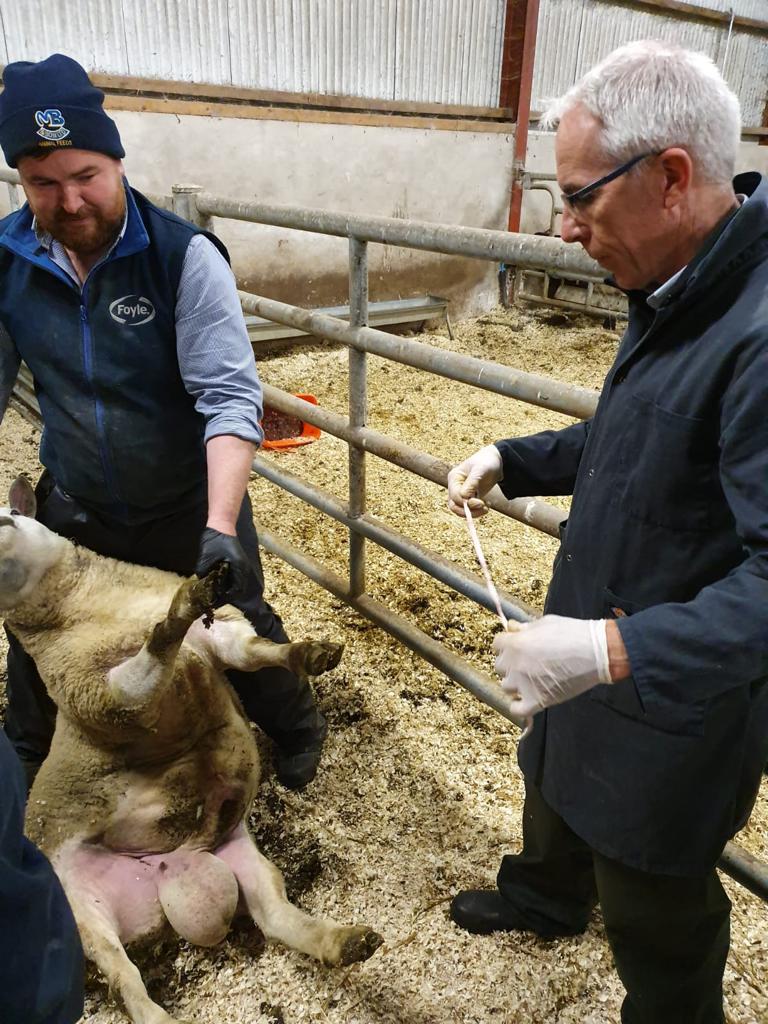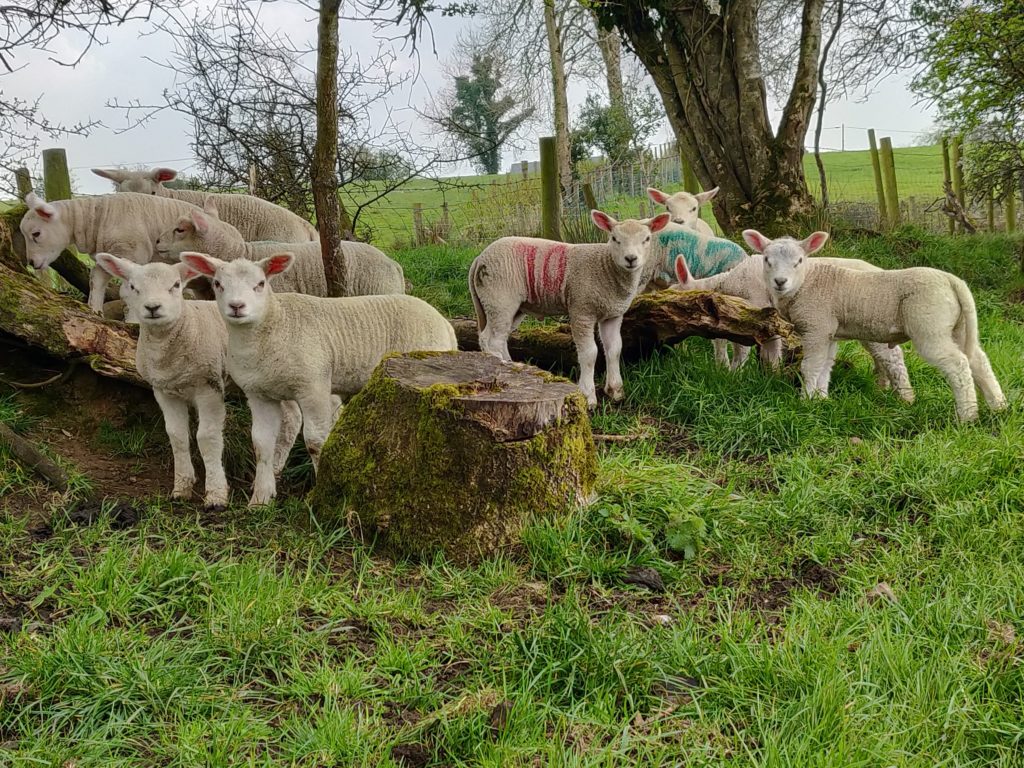Make sure your rams are fit for purpose this breeding season
July 31, 2020
Rachel Megarrell, CAFRE Beef and Sheep Adviser, Coleraine.
With the breeding season just around the corner attention at this time of year on the sheep farm will turn to flock assembly. It is essential to ensure that rams have been well prepared for the tupping period to ensure that he can perform to his reproductive potential. Is it advisable to check your rams at least 10-12 weeks ahead of the start of the breeding season. You should carry out a full ‘MOT’ on your breeding rams to determine fitness and suitability for tupping, this will mean you can detect any potential issues allowing time to correct them or to source a replacement if necessary. Ram fertility can be affected by a number of things for example, condition score, increased temperature caused by an infection, poor disease status and condition of the feet.

Body Condition Score (BCS)
Condition scoring is a standard handling technique to assess how much muscle and fat, breeding sheep are carrying at a particular time. It has been proved that over fat and thin ewes do not perform to their full potential and the same principle will apply to breeding rams. Body condition scoring is an integral part of the shepherd’s routine throughout the year and is particularly important pre-breeding.
Body condition score is assessed by handling the animal over and around the backbone, in the area of the loin behind the last rib and the tail head. Using the fingertips, firstly feel the degree of sharpness or roundness of the lumbar vertebrae. Secondly feel and assess the prominence and degree of cover over the horizontal processes. Then assess by feel the amount of muscle and fat under the horizontal processes, by the ease with which the fingers pass under the ends of these bones. Finally assess the eye muscle and its fat cover, by pressing the fingers into the area between the vertical and horizontal processes.
Taking these assessments into account, it is possible to score the animal on a scale of 0-5, using half scores as intermediate points along the scale. A body condition score of 4.0 for lowland rams at mating is ideal. Remember that rams will need a lot of reserves during the 6-8 week mating period and therefore some supplementary feeding in the run up to the tupping season might be required. Assessment of condition should be made approximately 8 weeks prior to tupping, so that rams in poorer condition can be fed a good quality ration to increase body condition however, the key is to have rams that are fit and ready to work and not excessively fat.

Teeth
Check for a broken mouth, under or overshot jaw and mouth abscesses all of which will affect the rams ability to feed effectively which will lead to rapid loss of condition.
Treatments
Rams should be subject to the same treatments as ewes for clostridial diseases, worms and fluke. Check the ram’s brisket for sores are these will need treatment well ahead of fitting a harness
Feet and locomotion
Healthy feet are extremely important if the ram is to perform successfully. Overgrown hooves can be pared back if they are affecting mobility however, it is now widely recognised that excessive foot paring is not necessary and poor trimming technique can lead to the formation of granulomas, misshapen hooves and the introduction of infection. Rams need to be monitored carefully for signs of footrot. Foot-rot vaccination should be considered for rams and requires two primary doses followed by a booster vaccination every 6 months. Ram mobility is important, check the joints for signs of swelling or excess fluid and make sure that he can move with a free gait as he will spend the majority of his time moving through the flock seeking out ewes that are in season.
Fertility examination
When selecting or culling rams many of the points that apply to ewes such as teeth, age and condition are relevant however, special attention should be given to the reproductive area. Testicles should be even in size, firm and resilient to pressure and able to move freely within the scrotum. Larger testicles indicate increased fertility. The prepuce should be checked for ulceration and for free movement of the penis through the orifice of the prepuce. The epididymis (sperm store) should be well defined with no lumps. If there is any doubt on ram fertility contact your local vet to semen sample to check that the rams are fertile.
Purchase of replacement lambs
This can be divided into 3 areas:
Selection – Check all areas of the ram carefully using the same procedure for a pre-breeding MOT. The rams mouth and pasterns should be correct, it should have good locomotion and it should conform to the breed standard. At a pedigree sale all animals will have passed a pre-sale inspection however it is still important to handle rams before purchase.

Purchase – There will also be a tremendous range of quality and prices available however the highest priced sheep will generally be those which have been well managed and carefully selected for size and appearance. The high prices of these sheep may be difficult to justify on the basis of physical and financial performance. However at the other extreme, poorly bred or impoverished sheep may be cheap but not necessarily a good buy, due to poor productivity. Sheep in the middle band probably represent best value for money. At present markets are running under strict regulations in line with COVID-19 social distancing guidelines, in most instances buyers will have to register and in some cases can avail of online bidding.
Aftercare – In most cases the farmer will not be familiar with the background of the purchased stock. Therefore it is better not to take any chances and to carry out the following treatments;
1. Dose for fluke and worms on arrival. Use of a 4-AD monepantel is recommended as a quarantine dose.
2. Vaccination programme.
3. Protection from scab.
4. Footbath.
Rams should be quarantined for a period of at least 3 weeks to avoid introducing unwanted problems into the flock such as contagious ovine digital dermatitis (CODD), resistant worms or scab to name a few.
Paying attention to the health and well-being of your breeding rams is crucial, the temptation is to forget about them after they have been removed from the ewes however, rams need to be carefully managed all year round to ensure that they remain in optimum condition. Do not underestimate the importance of this – remember the ram is half of your flock.
